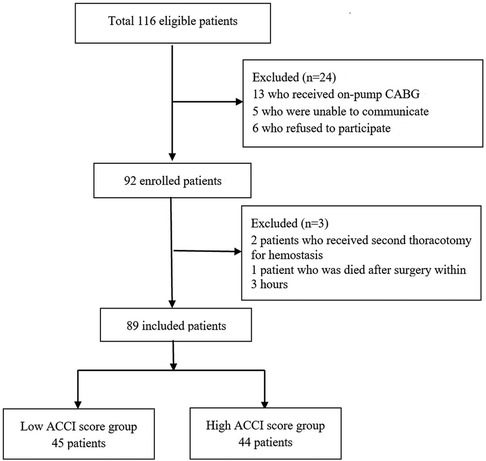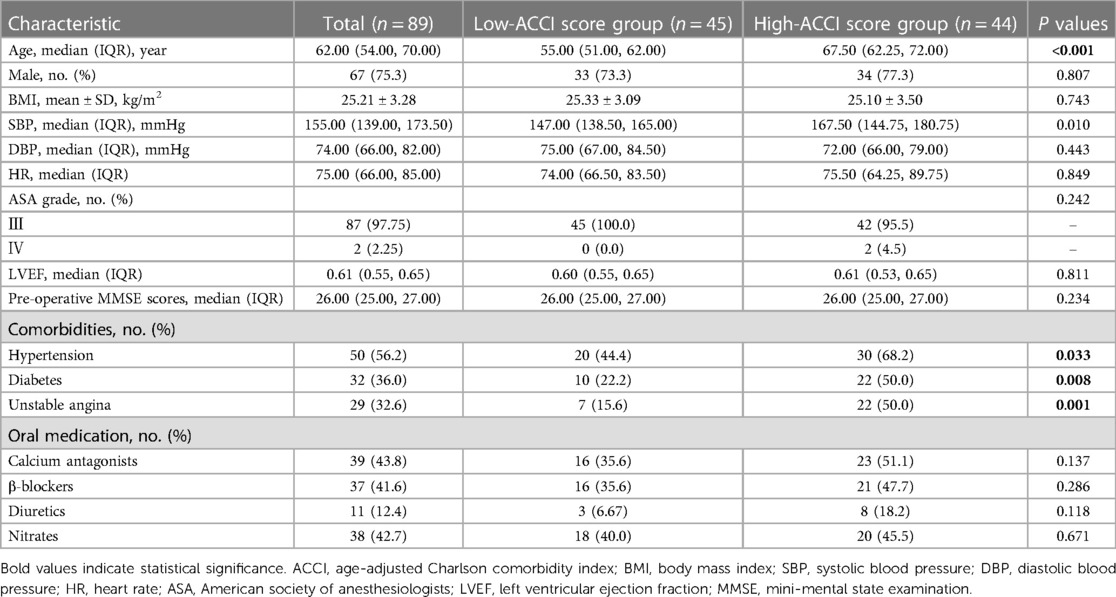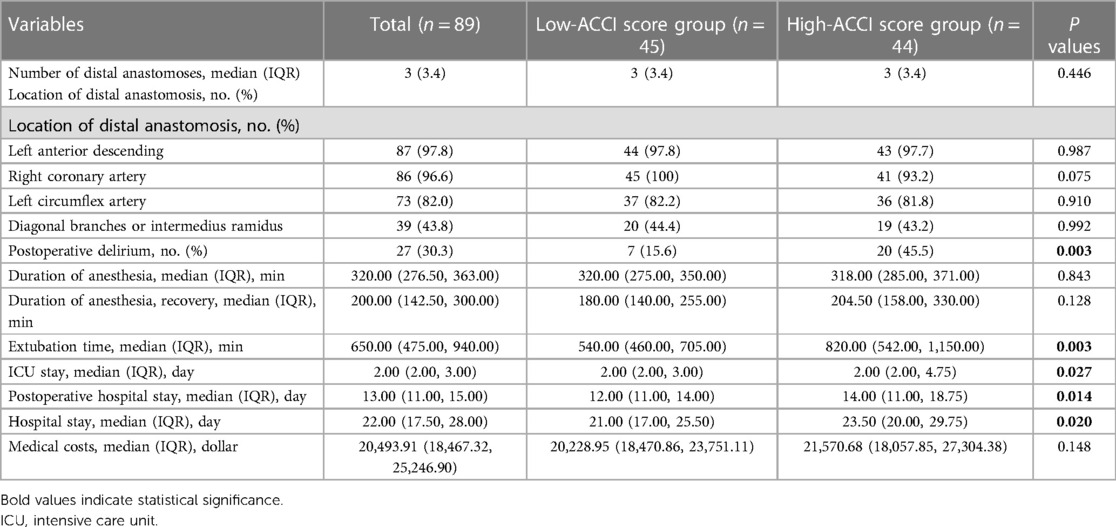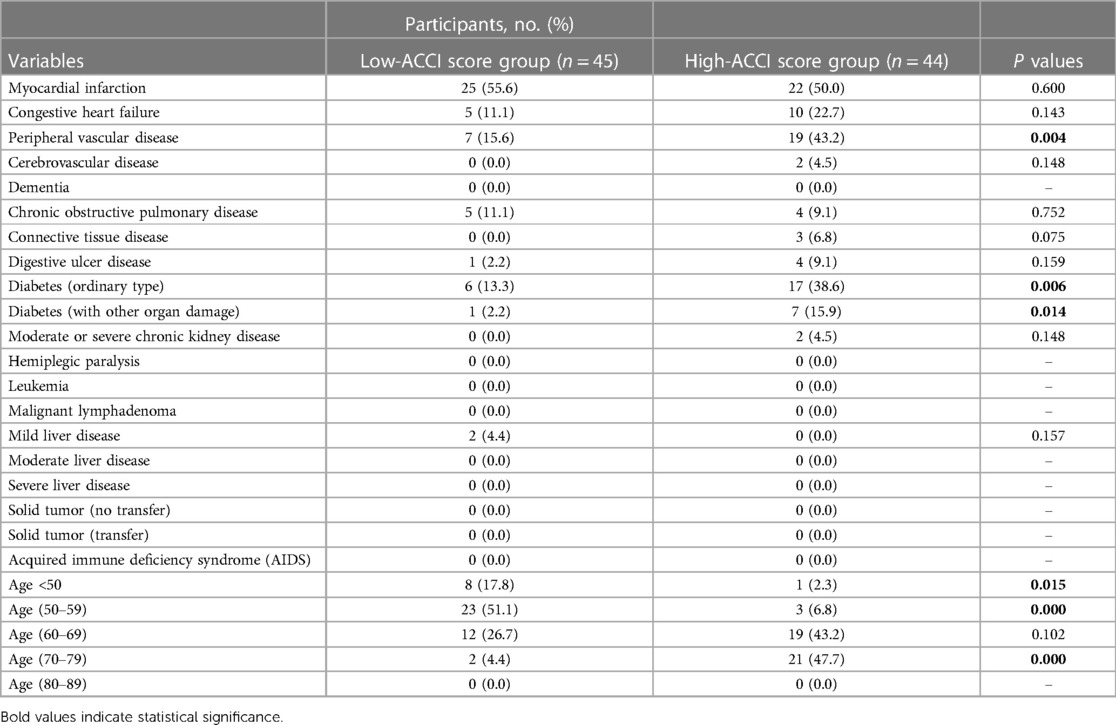- 1Department of Geriatric Medicine, Qilu Hospital (Qingdao), Cheeloo College of Medicine, Shandong University, Qingdao, China
- 2Department of Respiration, The Second Hospital of Shandong University, Jinan, Shandong, China
- 3Department of Anesthesiology, Qilu Hospital of Shandong University, Jinan, Shandong, China
- 4B.S. Neuroscience, Center for Research on Cardiac Intermediate Filaments, Johns Hopkins University School of Medicine, Baltimore, MD, United States
- 5Center for Research on Cardiac Intermediate Filaments, Johns Hopkins University School of Medicine, Baltimore, MD, United States
- 6Department of Geriatric Medicine, Qilu Hospital of Shandong University, Jinan, Shandong, China
Background: Postoperative delirium (POD) presents as a serious neuropsychiatric syndrome in patients undergoing off-pump coronary artery bypass grafting (OPCABG) surgery. This is correlated with higher mortality, cognitive decline, and increased costs. The Age-adjusted Charlson Comorbidity Index (ACCI) is recognized as an independent predictor for mortality and survival rate. The purpose of our study is to estimate the predictive value of the ACCI on the POD in patients undergoing OPCABG surgery.
Methods: This prospective cohort study enrolled patients undergoing OPCABG surgery between December 2020 and May 2021 in Qilu Hospital. Patients were divided into the low-ACCI group (score, 0–3) and the high-ACCI group (score ≥4) according to their ACCI scores. The Confusion Assessment Method for the Intensive Care Unit (CAM-ICU) and CAM were used to diagnose POD within 7 days after surgery. The general, laboratory, and clinical data of the patients were recorded and collected. The characteristic ROC curve was applied to further assess the predictive value of the ACCI for POD in patients following OPCABG surgery.
Results: A total of 89 patients were enrolled, including 45 patients in the low-ACCI group and 44 patients in the high-ACCI group. The incidence of POD was higher in the high-ACCI group than in the low-ACCI group (45.5% vs. 15.6%, P = 0.003). Multivariate logistic regression analyses showed that the ACCI (OR, 2.433; 95% CI, 1.468–4.032; P = 0.001) was an independent risk factor for POD. The ACCI accurately predicted POD in patients following OPCABG surgery with an AUC of 0.738, and the Hosmer–Lemeshow goodness of fit test yielded X2 = 5.391 (P = 0.145).
Conclusion: The high-ACCI group showed a high incidence of POD. The ACCI was an independent factor associated with POD in patients following OPCABG surgery. In addition, the ACCI could accurately predict POD in patients following OPCABG surgery.
Clinical Trial Registration: ClinicalTrials.gov, identifier CHiCTR2100052811.
Introduction
As the aging of the population intensifies and the incidence of diabetes and obesity increases, the incidence of coronary heart disease (CAD) increases with each passing year. Despite the rapid development of percutaneous coronary stent implantation, coronary artery bypass grafting (CABG) remains the main surgical treatment for patients with multiple vessel lesions (1). The off-pump CABG procedure is more widespread and accepted with the development of instrumentation for the improvement of heart stabilization. The benefit of off-pump CABG (OPCABG) is the absence of an extracorporeal circuit (ECC) induced systemic inflammatory response and air embolism (2).
Postoperative delirium (POD) is an acute alteration in attention/cognition that mostly occurs 6%–56% of the time 2–5 days after cardiac surgery (3–5). It is well known that ECC has a significant impact on the occurrence of POD. However, the probability of POD in patients with OPCABG is still high and may be related to an increased risk of stroke induced by atherosclerosis or calcified embolism in patients with aortic calcification (6). The occurrence of POD is associated with increased mortality, increased hospital stay length, higher medical costs, and reduced cognitive function (4, 7, 8). Approximately 30%–40% of POD can be prevented (9); therefore, early identification and the control of reversible risk factors are key to preventing POD and reducing POD-related complications.
Several measurements have been developed to assess and grade the degree of comorbidities, including the Age-adjusted Charlson Comorbidity Index (ACCI). The ACCI covers multisystem diseases and weights the scores according to age and the severity of the disease, which is suitable for elderly patients with cardiovascular disease and multimorbidity (10). Heretofore, ACCI is mainly used to evaluate the long-term prognosis of patients undergoing non-cardiac surgery (11–13). Liu explored the relationship between the ACCI and POD and emphasized the predictive effect of the ACCI on POD in senior patients undergoing abdominal and thoracic surgery (14). The purpose of our study is to explore the predictive effect of the ACCI on POD in patients undergoing OPCABG surgery.
Methods
Study design and participants
This prospective study enrolled patients scheduled to undergo OPCABG surgery between December 2020 and May 2021 in Qilu Hospital of Shandong University. This study was conducted following the guidelines of the Consolidated Standards of Reporting Trials (CONSORT) and approved by Qilu Hospital of Shandong University Medical Ethics Committee (No. 2020-092). This study obtained written informed consent from all the participants and was registered at the China Clinical Trial Registry (CHiCTR2100052811). All procedures were carried out under the principles of the Helsinki Declaration. The recruitment and inclusion process are shown in Figure 1.
Data collection
The demographic characteristics, laboratory, and clinical data, including gender, age, body mass index (BMI), American Society of Anesthesiologists (ASA) grade, left ventricular ejection fraction (LVEF), comorbidity, and laboratory tests were prospectively recorded and examined.
At admission, the ACCI score was collected as follows. (1) Each of the following diseases was counted as 1 point: myocardial infarction, congestive heart failure, cerebrovascular disease/transient ischemic attack, peripheral vascular disease, chronic obstructive pulmonary disease, peptic ulcer, mild liver disease, connective tissue disease, and diabetes without complications. (2) Each of the following diseases was counted as 2 points: dementia/Alzheimer's disease, hemiplegia, moderate-to-severe chronic kidney disease, non-metastatic solid tumors within 5 years, leukemia, lymphoma, and diabetes with complications. (3) The following disease was counted as 3 points: moderate-to-severe liver disease. (4) Each of the following diseases was counted as 6 points: human immunodeficiency virus (HIV) infection and metastatic solid tumors. (5) Age stratification score: <50 years old was 0 points, 50–59 years old was 1 point, 60–69 years old was 2 points, 70–79 years old was 3 points, and ≥80 years old was 4 points. Patients with CABG were often associated with a variety of comorbidities, and they were divided into two groups according to the ACCI score. Patients with mild (ACCI score: 0–1) and moderate (ACCI score: 2–3) comorbidities were grouped into the low-ACCI group (ACCI score: 0–3), whereas patients with severe comorbidities were grouped into the high-ACCI group (ACCI score ≥4) (15).
All patients received routine anesthesia during the cardiac surgery. The induction drugs used were midazolam 0.03 mg/kg, etomidate 0.2 mg/kg, sufentanil 1.5 ug/kg, and rocuronium 1 mg/kg. During the operation, rocuronium was pumped at a constant speed of 1 mg/kg/h, and sevoflurane was inhaled to maintain anesthesia and sufentanil 1 ug/kg was added during sternotomy. During the operation, the mean arterial pressure (MAP) was maintained at more than 70 mmHg, and the bispectral index (BIS) was maintained at 40–60. After surgery, we transferred all the patients to the ICU for further treatment. Clinical data included drug dosage, BIS, body temperature, hemodynamics data, duration of anesthesia, number of distal anastomoses, and the locations of those anastomosis. Hospital stay, ICU stay, postoperative hospital stay, and medical costs were recorded at discharge.
In our study, we used the Mini-Mental State Examination (MMSE) to assess the pre-operative cognitive condition (16). The Confusion Assessment Method-Intensive Care Unit (CAM-ICU) was used to evaluate POD during the mechanical ventilation period (17). CAM was used to assess the occurrence of POD after the patient could communicate normally. The occurrence of POD was determined twice daily (09–11 a.m. and 19–21 p.m.) within 7 days after surgery by a blinded professional researcher. At any timepoint, if the criteria for diagnosing POD were met, we defined it as POD.
Outcomes
The primary outcome of our study was the incidence of POD in patients following OPCABG surgery. The secondary outcomes were extubation time, ICU stay, hospital stay, and medical cost.
Sample size and statistical analysis
PASS 15 (NCSS, LLC Kaysville, UT, USA) was used to calculate the study sample size. Previous studies reported that the incidence of POD after cardiac surgery was 6%–56% (5). To detect this difference, we set the delirium incidence rate as 20% in the low-ACCI group and 50% in the high-ACCI group, at a two-sided significance level of 0.05, with 80% power. We estimated a sample size of at least 39 subjects in each group. To account for a 10% loss to follow-up, we had a recruitment goal of 87 patients.
SPSS 26.0 software (IBM, Armonk, NY, USA) was used to perform the statistical analysis. The grouping of patients was blinded to statistical analysts. The Shapiro–Wilk test was used to test the normal distribution of the continuous data, and normal distribution data were expressed as mean ± standard deviation. Continuous data with a skewed distribution were represented as median (IQR). Continuous variables were compared by one-way analysis of variance (ANOVA). Categorical data were presented as frequency (percentage) and the chi-square test was used to compare the differences. We performed a logistic regression to detect independent predictors of POD. Receiver operator characteristic curves (ROC) with area under the curve (AUC) were used to detect the accuracy. Hosmer–Limeshow and calibration curves were used to evaluate the calibration of the prediction model. A two-tailed P value <0.05 was considered statistically significant.
Results
Initially, 116 patients undergoing OPCABG were included in our study of which 27 were excluded due to changing operation, poor communication, and second thoracotomy; therefore, 89 patients were included in the final analysis (Figure 1). Among them, 45 patients had ACCI scores of ≤3, and 44 patients had ACCI scores of ≥4. The high-ACCI group had a higher incidence of POD than the low-ACCI group (45.5% vs. 15.6%, P = 0.003). There were statistical differences in age, the incidence of postoperative delirium, and the incidence of comorbidities, including hypertension, diabetes, and unstable angina between the two groups (P < 0.05). Patients in the high-ACCI group had a longer extubation time (P = 0.003), ICU stay (P = 0.027), postoperative hospital stay (P = 0.014), and total hospital stay (P = 0.020) than the low-ACCI group. There were no statistical differences in the number and location of distal anastomoses between the two groups (Tables 1, 2). In addition, the incidence of each comorbidity of the ACCI in both patient groups is shown in Table 3. Detailed laboratory findings at admission are listed in Supplementary Material Table S1. No significant differences were detected among the two groups (P > 0.05). The hemodynamics and application of inotropes during the perioperative period are shown in Supplementary Material Table S2.
The POD was significantly correlated with age, ACCI, pre-operative MMSE scores, extubation time, and ICU stay. Multivariate logistic regression showed that ACCI was independently correlated with POD (β = 0.889, P = 0.001) (Table 4).
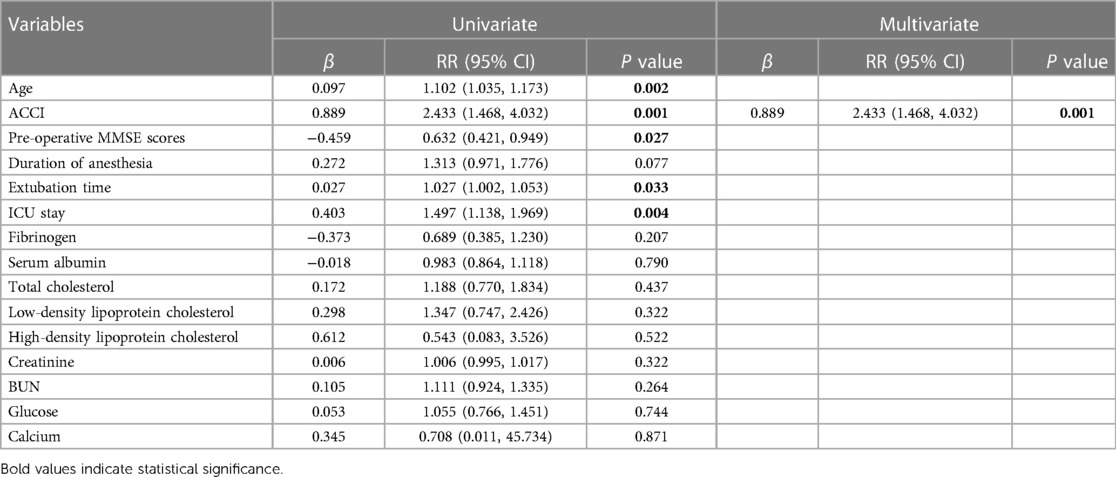
Table 4. Univariate and multivariate logistic regression analyses of clinical associated risk factors for postoperative delirium (POD).
The characteristic ROC curve was applied to evaluate the predictive value of the ACCI for POD in patients following OPCABG surgery. Based on ROC analysis, the largest AUC was 0.738 and the sensitivity of the ACCI was 1.0. The optimal cutoff value of the ACCI was 2.5 for predicting POD in patients following OPCABG surgery, as shown in Figure 2A. In the Hosmer–Limeshow goodness-of-fit test, X2 = 5.391 (P = 0.145), indicating that there was no statistical difference between the predicted values of the model and the actual observed values. The validation results of the model were displayed in the calibration curve of the prediction model, as shown in Figure 2B.
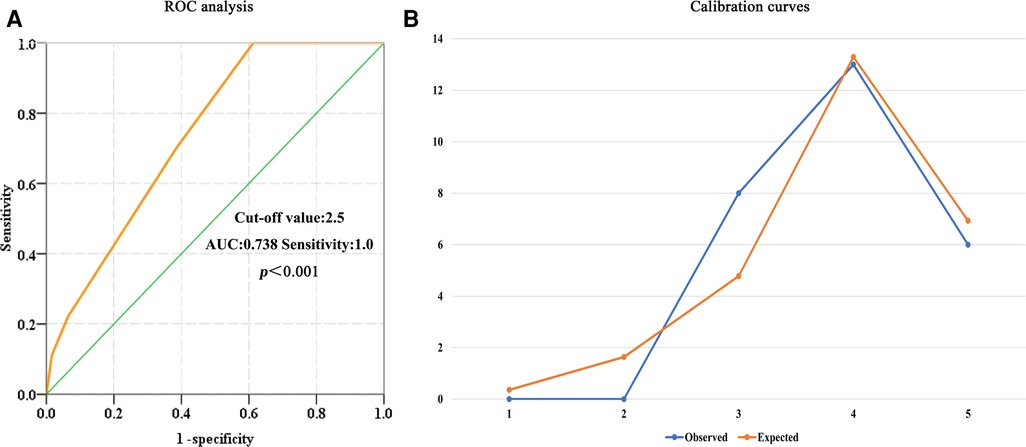
Figure 2. The predictive value of the ACCI for POD. (A) ROC analysis: the largest AUC is 0.738, the sensitivity of the ACCI is 1.0, and the optimal cutoff value of the ACCI is 2.5. (B) Calibration curves: the Hosmer–Limeshow goodness-of-fit test yielded X2 = 5.391 (P = 0.145). ACCI, age-adjusted Charlson comorbidity index; POD, postoperative delirium; ROC, receiver operating characteristic; AUC, the area under the curve.
Discussion
Our prospective cohort study first revealed the predictive value of the ACCI for POD in patients following OPCABG surgery. Our study revealed that the high-ACCI group had a higher incidence of POD. Furthermore, our study indicated that the ACCI was independently associated with POD and can accurately predict POD in patients following OPCABG surgery.
Among all types of surgery, the incidence of POD occurred predominantly after cardiac surgery. In our study, the average occurrence of POD in patients following OPCABG surgery was 30.3%. The high-ACCI group had a significantly higher incidence of POD than the low-ACCI group (45.5% vs. 15.6%). The risk factors associated with POD included advanced age, preoperative co-morbidities, frailty, prolonged preoperative fasting, cardiopulmonary bypass time, depth of anesthesia, and medications during the perioperative period (18–20). We found that the POD was significantly correlated with age, the ACCI, pre-operative MMSE scores, extubation time, and ICU stay. For the controllable risk factors, optimization should be carried out during the perioperative period.
The ACCI was particularly well suited for classifying the comorbidities and estimating mortality from comorbid diseases (13, 21–23). Tseng et al. assessed the effect of the ACCI on the hospital survival of patients undergoing extracorporeal cardiopulmonary resuscitation (ECPR) and found that a high ACCI was correlated with a higher mortality rate (24). Zhang et al. investigated the correlation between the ACCI score and readmission/mortality in senior surgical patients (13). They demonstrated that the ACCI was independently associated with hospital readmission and all-cause mortality. The above studies mainly focused on the relationship between the ACCI and long-term prognosis in non-cardiac surgery. Liu et al. explored the correlation between the ACCI and POD and highlighted the predictive significance of the ACCI on POD in senior patients undergoing abdominal and thoracic surgery (14). They found that the ACCI was a sensitive predictive factor for POD, and the optimal intercept value of the ACCI was 5.5 according to ROC analysis. According to our research, the ACCI had high prediction sensitivity and specificity in patients following OPCABG surgery and the optimal cutoff value was 2.5. The reasons for this difference were the different study populations, the large trauma of cardiac surgery, the longer operation time, the higher dosage of opioid drugs during cardiac operation, the longer intubation, the impact of the ICU environment, and the inability of family members to accompany the patient after the operation.
The MMSE, which is a simple method for evaluating cognitive status, can identify POD early and deserved more attention as lower MMSE scores were typically associated with a higher risk of delirium (16, 25, 26). Segernäs found that pre-operative MMSE scores less than 27 were independently associated with a high risk of POD after cardiac surgery (16). Our finding was consistent with the results of this study. Our study detected that pre-operation MMSE was a negative factor associated with POD (β = −0.459, P = 0.027).
Previous studies have shown that POD is closely associated with a prolonged ICU stay (4, 27, 28). Patients with POD exhibited cognitive impairment and abnormal behavior, which were associated with an increased risk of bleeding, infection, and cerebrovascular accidents (4, 29). These complications increased ICU stay, the cost, and the length of rehabilitation. Our study confirmed a positive association between POD occurrence and ICU stay according to the results of logistic regression. Previous studies have shown that appropriate measures, such as earlier extubation, the promotion of patient mobility, pain control, POD prevention, nutrition, gastrointestinal function, and fluid management, can reduce the length of ICU stay (30).
There were several limitations in this study. First, this study was a single-center prospective study, and the number of cases involved was limited. Second, the ACCI was designed as a general predictor of mortality and outcomes. The ACCI might not capture nuances specific to OPCABG. In addition, the long-term follow-up results were not included. Further multicenter studies with large sample sizes are needed to verify the findings.
Conclusion
In conclusion, the high-ACCI group had a higher incidence of POD, and the ACCI can accurately predict POD in patients following OPCABG surgery. The ACCI was independently associated with POD in patients undergoing OPCABG surgery. Appropriate risk stratification through the ACCI can manage POD through risk reduction measures and preventive interventions.
Data availability statement
The raw data supporting the conclusions of this article will be made available by the authors, without undue reservation.
Ethics statement
The studies involving humans were approved by Qilu Hospital of Shandong University Medical Ethics Committee (No. 2020-092). The studies were conducted in accordance with the local legislation and institutional requirements. The participants provided their written informed consent to participate in this study.
Author contributions
Study design: YM, ZW, NF; data collection: YM, XY, NF; analysis results: DS, SY; revised draft and agreed with the publication: MY, DS, JO, JS, NF. All authors contributed to the article and approved the submitted version.
Funding
This study was supported by the Natural Science Foundation of Shandong Province (ZR2021MH181).
Conflict of interest
The authors declare that the research was conducted in the absence of any commercial or financial relationships that could be construed as a potential conflict of interest.
Publisher's note
All claims expressed in this article are solely those of the authors and do not necessarily represent those of their affiliated organizations, or those of the publisher, the editors and the reviewers. Any product that may be evaluated in this article, or claim that may be made by its manufacturer, is not guaranteed or endorsed by the publisher.
Supplementary material
The Supplementary Material for this article can be found online at: https://www.frontiersin.org/articles/10.3389/fcvm.2023.1251617/full#supplementary-material
References
1. Rantanen M, Yousif R, Kallioinen M, Hynninen VV, Peltoniemi M, Söderholm O, et al. Retrospective observational analysis of a coronary artery bypass grafting surgery patient cohort: off-pump versus on-pump. Ann Med Surg. (2022) 84:104812. doi: 10.1016/j.amsu.2022.104812
2. Ofoegbu CKP, Manganyi RM. Off-pump coronary artery bypass grafting; is it still relevant? Curr Cardiol Rev. (2022) 18(2):e271021197431. doi: 10.2174/1573403X17666211027141043
3. Jones D, Matalanis G, Mårtensson J, Robbins R, Shaw M, Seevanayagam S, et al. Predictors and outcomes of cardiac surgery-associated delirium. A single centre retrospective cohort study. Heart Lung Circ. (2019) 28(3):455–63. doi: 10.1016/j.hlc.2018.01.007
4. Lin L, Zhang X, Xu S, Peng Y, Li S, Huang X, et al. Outcomes of postoperative delirium in patients undergoing cardiac surgery: a systematic review and meta-analysis. Front Cardiovasc Med. (2022) 9:884144. doi: 10.3389/fcvm.2022.884144
5. Wueest AS, Berres M, Bettex DA, Steiner LA, Monsch AU, Goettel N. Independent external validation of a preoperative prediction model for delirium after cardiac surgery: a prospective observational cohort study. J Cardiothorac Vasc Anesth. (2023) 37(3):415–22. doi: 10.1053/j.jvca.2022.11.038
6. O'Neal JB, Billings FTT, Liu X, Shotwell MS, Liang Y, Shah AS, et al. Risk factors for delirium after cardiac surgery: a historical cohort study outlining the influence of cardiopulmonary bypass. Can J Anaesth. (2017) 64(11):1129–37. doi: 10.1007/s12630-017-0938-5
7. Daza-Arana JE, Lozada-Ramos H, Ávila-Hernández DF, Ordoñez-Mora LT, Sánchez DP. Prolonged mechanical ventilation following coronary artery bypass graft in Santiago De Cali, Colombia. Vasc Health Risk Manag. (2022) 18:767–81. doi: 10.2147/VHRM.S367108
8. Brown CHT, Probert J, Healy R, Parish M, Nomura Y, Yamaguchi A, et al. Cognitive decline after delirium in patients undergoing cardiac surgery. Anesthesiology. (2018) 129(3):406–16. doi: 10.1097/ALN.0000000000002253
9. Devlin JW, Skrobik Y, Gélinas C, Needham DM, Slooter AJC, Pandharipande PP, et al. Clinical practice guidelines for the prevention and management of pain, agitation/sedation, delirium, immobility, and sleep disruption in adult patients in the ICU. Crit Care Med. (2018) 46(9):e825–73. doi: 10.1097/CCM.0000000000003299
10. Charlson M, Szatrowski TP, Peterson J, Gold J. Validation of a combined comorbidity index. J Clin Epidemiol. (1994) 47(11):1245–51. doi: 10.1016/0895-4356(94)90129-5
11. Kang HW, Kim SM, Kim WT, Yun SJ, Lee SC, Kim WJ, et al. The age-adjusted Charlson comorbidity index as a predictor of overall survival of surgically treated non-metastatic clear cell renal cell carcinoma. J Cancer Res Clin Oncol. (2020) 146(1):187–96. doi: 10.1007/s00432-019-03042-7
12. Kim DH, Park HC, Cho A, Kim J, Yun KS, Kim J, et al. Age-adjusted Charlson comorbidity index score is the best predictor for severe clinical outcome in the hospitalized patients with COVID-19 infection. Medicine (Baltimore). (2021) 100(18):e25900. doi: 10.1097/MD.0000000000025900
13. Zhang XM, Wu XJ, Cao J, Guo N, Bo HX, Ma YF, et al. Effect of the age-adjusted Charlson comorbidity index on all-cause mortality and readmission in older surgical patients: a national multicenter, prospective cohort study. Front Med (Lausanne). (2022) 9:896451. doi: 10.3389/fmed.2022.896451
14. Liu J, Li J, He J, Zhang H, Liu M, Rong J. The age-adjusted Charlson comorbidity index predicts post-operative delirium in the elderly following thoracic and abdominal surgery: a prospective observational cohort study. Front Aging Neurosci. (2022) 14:979119. doi: 10.3389/fnagi.2022.979119
15. Zheng W, Huang X, Suo M, Wang X, Zhao XD, Gong W, et al. Protocol for the FACE study: frailty and comorbidity in elderly patients-a multicenter, Chinese observational cohort study. J Geriatr Cardiol. (2023) 20(1):83–90. doi: 10.26599/1671-5411.2023.01.009
16. Segernäs A, Skoog J, Ahlgren Andersson E, Almerud Österberg S, Thulesius H, Zachrisson H. Prediction of postoperative delirium after cardiac surgery with a quick test of cognitive speed, Mini-mental state examination and hospital anxiety and depression scale. Clin Interv Aging. (2022) 17:359–68. doi: 10.2147/CIA.S350195
17. Faisal H, Farhat S, Grewal NK, Masud FN. ICU delirium in cardiac patients. Methodist Debakey Cardiovasc J. (2023) 19(4):74–84. doi: 10.14797/mdcvj.1246
18. Aldecoa C, Bettelli G, Bilotta F, Sanders RD, Audisio R, Borozdina A, et al. European society of anaesthesiology evidence-based and consensus-based guideline on postoperative delirium. Eur J Anaesthesiol. (2017) 34(4):192–214. doi: 10.1097/EJA.0000000000000594
19. Pang Y, Li Y, Zhang Y, Wang H, Lang J, Han L, et al. Effects of inflammation and oxidative stress on postoperative delirium in cardiac surgery. Front Cardiovasc Med. (2022) 9:1049600. doi: 10.3389/fcvm.2022.1049600
20. Bossone E, Cademartiri F, AlSergani H, Chianese S, Mehta R, Capone V, et al. Preoperative assessment and management of cardiovascular risk in patients undergoing non-cardiac surgery: implementing a systematic stepwise approach during the COVID-19 pandemic era. J Cardiovasc Dev Dis. (2021) 8(10):126. doi: 10.3390/jcdd8100126
21. Qu WF, Zhou PY, Liu WR, Tian MX, Jin L, Jiang XF, et al. Age-adjusted Charlson comorbidity index predicts survival in intrahepatic cholangiocarcinoma patients after curative resection. Ann Transl Med. (2020) 8(7):487. doi: 10.21037/atm.2020.03.23
22. Bonaventura A, Leale I, Carbone F, Liberale L, Dallegri F, Montecucco F, et al. Pre-surgery age-adjusted Charlson comorbidity index is associated with worse outcomes in acute cholecystitis. Dig Liver Dis. (2019) 51(6):858–63. doi: 10.1016/j.dld.2018.10.002
23. Minol JP, Dimitrova V, Petrov G, Langner R, Boeken U, Rellecke P, et al. The age-adjusted Charlson comorbidity index in minimally invasive mitral valve surgery. Eur J Cardiothorac Surg. (2019) 56(6):1124–30. doi: 10.1093/ejcts/ezz240
24. Tseng LJ, Yu HY, Wang CH, Chi NH, Huang SC, Chou HW, et al. Impact of age-adjusted Charlson comorbidity on hospital survival and short-term outcome of patients with extracorporeal cardiopulmonary resuscitation. J Clin Med. (2018) 7(10):313. doi: 10.3390/jcm7100313
25. Cao SJ, Chen D, Yang L, Zhu T. Effects of an abnormal mini-mental state examination score on postoperative outcomes in geriatric surgical patients: a meta-analysis. BMC Anesthesiol. (2019) 19(1):74. doi: 10.1186/s12871-019-0735-5
26. Wu Y, Shi Z, Wang M, Zhu Y, Li C, Li G, et al. Different MMSE score is associated with postoperative delirium in young-old and old-old adults. PLoS One. (2015) 10(10):e0139879. doi: 10.1371/journal.pone.0139879
27. Lin JL, Zheng GZ, Chen LW, Luo ZR. A nomogram model for assessing predictors and prognosis of postoperative delirium in patients receiving acute type A aortic dissection surgery. BMC Cardiovasc Disord. (2023) 23(1):72. doi: 10.1186/s12872-023-03111-3
28. Huang H, Han J, Li Y, Yang Y, Shen J, Fu Q, et al. Early serum metabolism profile of post-operative delirium in elderly patients following cardiac surgery with cardiopulmonary bypass. Front Aging Neurosci. (2022) 14:857902. doi: 10.3389/fnagi.2022.857902
29. Sugimura Y, Sipahi NF, Mehdiani A, Petrov G, Awe M, Minol JP, et al. Risk and consequences of postoperative delirium in cardiac surgery. Thorac Cardiovasc Surg. (2020) 68(5):417–24. doi: 10.1055/s-0040-1708046
Keywords: postoperative delirium, ACCI, OPCABG, ICU stay, prospective study
Citation: Ma Y, Sui D, Yang S, Yang X, Oldam J, Semel JL, Wang Z and Fang N (2023) Optimal postoperative delirium prediction after coronary artery bypass grafting surgery: a prospective cohort study. Front. Cardiovasc. Med. 10:1251617. doi: 10.3389/fcvm.2023.1251617
Received: 2 July 2023; Accepted: 27 November 2023;
Published: 8 December 2023.
Edited by:
Jacob Bergsland, Oslo University Hospital, NorwayReviewed by:
Thierry Caus, University of Picardie Jules Verne, FranceHe Liu, Zhejiang University School of Medicine & Huzhou Central Hospital, China
Faizus Sazzad, National University of Singapore, Singapore
© 2023 Ma, Sui, Yang, Yang, Oldam, Semel, Wang and Fang. This is an open-access article distributed under the terms of the Creative Commons Attribution License (CC BY). The use, distribution or reproduction in other forums is permitted, provided the original author(s) and the copyright owner(s) are credited and that the original publication in this journal is cited, in accordance with accepted academic practice. No use, distribution or reproduction is permitted which does not comply with these terms.
*Correspondence: Ningning Fang bmluZ25pbmdmYW5nQDEyNi5jb20=
†These authors have contributed equally to this work and share first authorship
 Ying Ma1,†
Ying Ma1,† Dongxin Sui
Dongxin Sui Shaozhong Yang
Shaozhong Yang Xiaomei Yang
Xiaomei Yang Joseph Oldam
Joseph Oldam Zhihao Wang
Zhihao Wang Ningning Fang
Ningning Fang